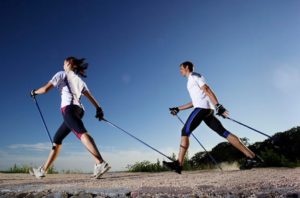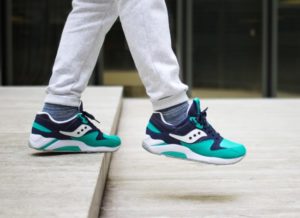Nordic or Norwegian walking is becoming increasingly popular. Many people, especially older people, willingly engage in it to maintain their health. It is important to choose the right shoes for such activities. What it should be, read in this article.
Criteria for choosing shoes for Nordic walking
 These, of course, must be sneakers. But there are a lot of types of sports shoes and not everyone is suitable for such activities. A separate category specifically designed for Nordic walking has not yet been invented. You have to choose from what is available. Experts advise paying attention to running and trekking sneakers (designed specifically for walking on rough terrain and hiking; they have a fairly rigid last). Each type has its nuances. Let's figure out what you should pay attention to.
These, of course, must be sneakers. But there are a lot of types of sports shoes and not everyone is suitable for such activities. A separate category specifically designed for Nordic walking has not yet been invented. You have to choose from what is available. Experts advise paying attention to running and trekking sneakers (designed specifically for walking on rough terrain and hiking; they have a fairly rigid last). Each type has its nuances. Let's figure out what you should pay attention to.
Options
 First of all, you need such shoes to be comfortable. When walking long distances, it is important to feel confident and comfortable. Shoes must fit correctly, not hang loose on the foot, and not be too tight.. Make sure there is at least a centimeter between your toes and the toe of the sneaker. Fingers should bend freely.
First of all, you need such shoes to be comfortable. When walking long distances, it is important to feel confident and comfortable. Shoes must fit correctly, not hang loose on the foot, and not be too tight.. Make sure there is at least a centimeter between your toes and the toe of the sneaker. Fingers should bend freely.
Shoes for Nordic walking need to be fairly light. Otherwise, the load on the joints will be high, and this is dangerous. And of course, you have to like the sneakers!
Advice! Try on the socks you plan to wear for training. This will allow you to more accurately determine the size.
Good cushioning
When walking, especially fast enough, a shock load is applied to the foot. Shock absorbers will help soften it and thereby protect the joints of the legs. Good sneakers must have them. Check the sole carefully - you can feel the shock-absorbing pads in the heels and toes.
Important! If you have joint disease, you need to use orthopedic shoes with wide and round toes. Consult your doctor before purchasing!
The sole is wide and flexible
Avoid hard soles. Ideally, it should follow all the curves of the foot when moving, and that means it should be flexible. Thin is also not an option. You will feel uneven surfaces, which can cause pain in your feet. Try to choose a couple that has The sole is quite stable and wide.
Good grip
 This is for stability. There are no flat soles (like basketball shoes), but you don’t need spikes either, you’re not going to play football. When practicing Nordic walking, you will have to walk on different surfaces - asphalt, earth, stones, which means the relief of the sole should be moderate. Don't choose sneakers with very thick soles. Such models have little grip on the surface. So save the trendy platform sneakers for shopping.They have nothing to do with sports shoes.
This is for stability. There are no flat soles (like basketball shoes), but you don’t need spikes either, you’re not going to play football. When practicing Nordic walking, you will have to walk on different surfaces - asphalt, earth, stones, which means the relief of the sole should be moderate. Don't choose sneakers with very thick soles. Such models have little grip on the surface. So save the trendy platform sneakers for shopping.They have nothing to do with sports shoes.
High quality fasteners
It’s better not just fasteners, but laces. They allow you to adjust the volume, which will make the sneakers more comfortable. They just get untied at the most inopportune moment. To prevent this from happening, make sure that the laces are made of a special non-slip material and are flat in shape.
Interesting! Modern sports shoes have a quick lacing system. Suitable for those who find it difficult to tie and untie shoelaces.
Durable material
Don't skimp on equipment. Sports shoes must be of high quality, wear-resistant and reliable. Nordic walking is not a multi-day hike in the forest, but there will be stones and sticks under your feet even in the park, so your sneakers should be able to withstand the load with dignity. The best choice is genuine leather.
Advice! Do not dry your sneakers near heat sources. This may lead to their deformation.
High heel
 It should be much lower than the toe, which will allow you to roll your leg well - the movements will be smooth and will not cause discomfort. The heel in the shoe is designed to fix the foot, protecting the leg from dislocations. Under no circumstances should the backdrop move when walking. Otherwise, you will rub a callus and will not be able to exercise.
It should be much lower than the toe, which will allow you to roll your leg well - the movements will be smooth and will not cause discomfort. The heel in the shoe is designed to fix the foot, protecting the leg from dislocations. Under no circumstances should the backdrop move when walking. Otherwise, you will rub a callus and will not be able to exercise.
Convenience and comfort of landing
Probably the most important condition. When purchasing, walk around in the store in your chosen shoes for at least a few minutes, make sure that you are comfortable and comfortable. If you suffer from overpronation (when your foot turns inward when running or walking), you need to purchase sneakers with stabilization, which will avoid the risk of joint injuries.
Which one to choose for the summer, which one to choose for the cold?
 Do not forget that the foot in the shoe must breathe. If you exercise only in the warm season and do not walk through large puddles and tall (often wet) grass, pay attention to sneakers with a special mesh or perforation.
Do not forget that the foot in the shoe must breathe. If you exercise only in the warm season and do not walk through large puddles and tall (often wet) grass, pay attention to sneakers with a special mesh or perforation.
But if it’s cold and rainy outside, but this is not a reason for you to postpone your workout, choose membrane. It has water-repellent properties and protects the foot from hypothermia. Frost-resistant models are suitable for winter training. Manufacturers usually indicate the wearing temperature on the tag.
Choosing shoes depending on the type of walking
 First of all decide where, for how long and at what speed you are going to practice Nordic walking. And if for beginners who decide to take a couple of laps along an asphalt park path, ordinary sneakers for everyday wear are suitable, then for long walks over rough terrain, sneakers and trekking boots will be the best choice. They are stiffer, but more reliable and better protect the foot from damage. Running shoes will be needed for fairly intense activities in the warm season.
First of all decide where, for how long and at what speed you are going to practice Nordic walking. And if for beginners who decide to take a couple of laps along an asphalt park path, ordinary sneakers for everyday wear are suitable, then for long walks over rough terrain, sneakers and trekking boots will be the best choice. They are stiffer, but more reliable and better protect the foot from damage. Running shoes will be needed for fairly intense activities in the warm season.


 0
0





